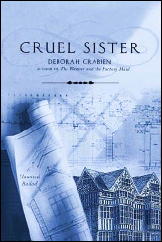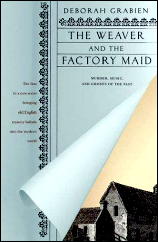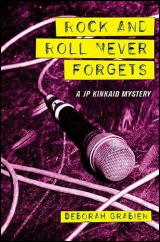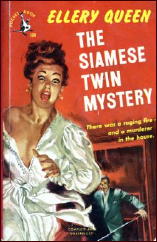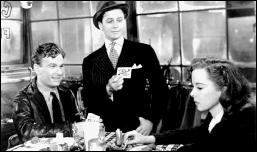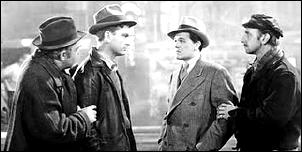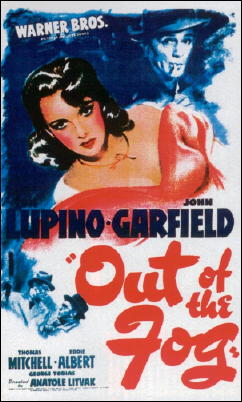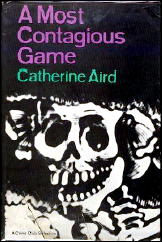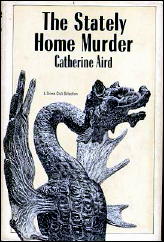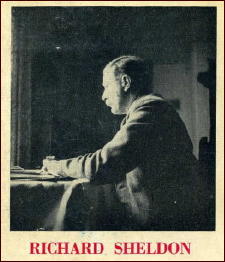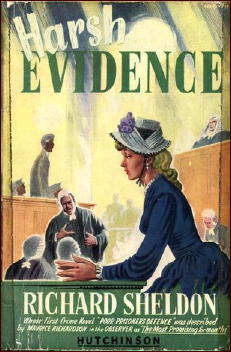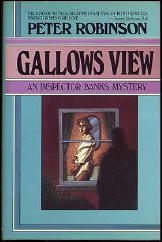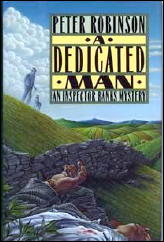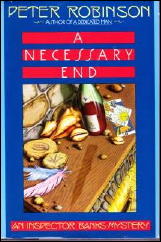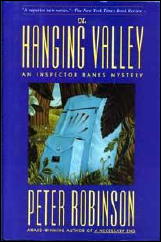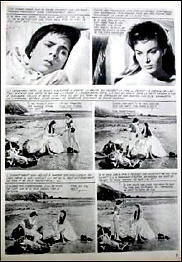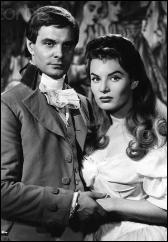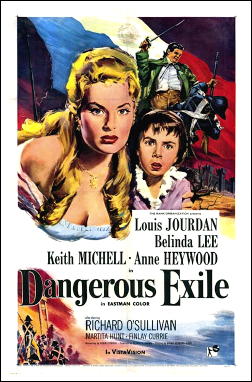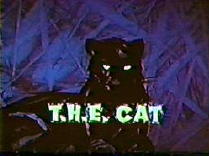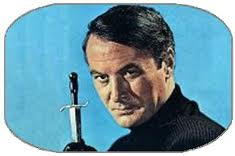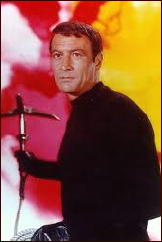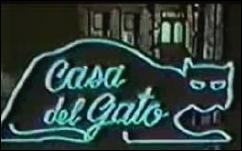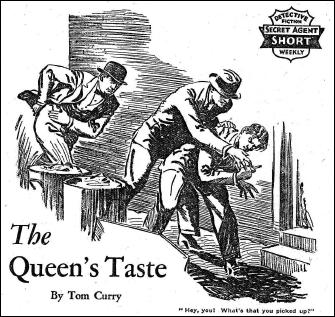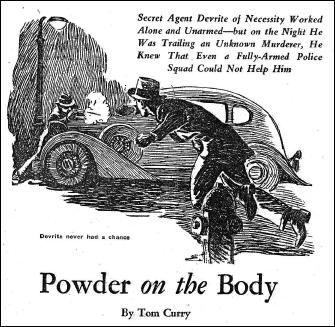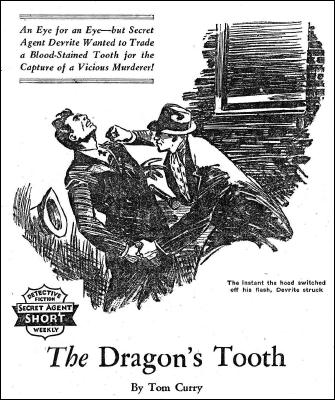THE SERIES CHARACTERS FROM
DETECTIVE FICTION WEEKLY
by MONTE HERRIDGE
#5. SECRET AGENT GEORGE DEVRITE, by Tom Curry.
The Secret Agent George Devrite stories by Tom Curry were a short series of seven stories published in Detective Fiction Weekly from 1936 to 1940.
The series involves the exploits of an undercover policeman, or secret agent, of the New York Police. Inspector Hallihan was his superior in the department, but George Devrite was in essence the Secret Police Chief. He had an obscure office on the second floor of a dingy house “down the street from Headquarters, outwardly an importer of beaded goods but actually the main receiver of reports made by such agents as Devrite.†(The Green Fingers of Death)
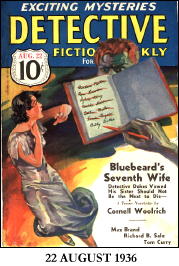
These reports often consist of factual accounts of their actions and gives recommendations to Hallihan of what to do – people to investigate, arrest, or otherwise take action about. Devrite “received credit only in the secret records of the Police.†(The Donkey’s Head) He lived in a small apartment in the West Forties, and had no close friends, as his job did not allow such.
As to entertainment, Devrite derived “his main amusement … in solving the puzzles presented by Hallihan.†(The Donkey’s Head) So Devrite could be described as a workaholic who lived for his job.
Devrite usually visited the scene of the murders he investigated in order to gather information. As Devrite puts it when he closes in on some criminals, “with twenty thousand policemen on tap but Devrite dared not call one to assist him directly, since he was an undercoverman and could not expose himself to friend or foe.†(The Green Fingers of Death)
Devrite’s orders at all times was to never expose himself. He did not make arrests or appear in court to give trial testimony. It was explained in the second story in the series (The Queen’s Taste), that “George Devrite was a valuable man – irreplaceable save by years of training; his natural competence and experience made him Hallihan’s star.†Part of Devrite’s training is in ju-jutsu, which he uses in a number of the stories, especially “The Dragon’s Tooth.â€
In the first story in the series, “The Green Fingers of Death,†one of Devrite’s fellow agents has been found murdered, and Hallihan gives the case that he was working on to Devrite to investigate. It involves a young bank clerk named Robert Evans, who is in some sort of trouble.
Devrite does some investigating and finds that Evans owes a gambling debt to a German named Count von Hult. Hult wants something unknown in return for this debt, which turns out to be passing counterfeit money at his bank. Devrite tracks down the counterfeiters and his earlier report to Hallihan set the police on their track too.
The second story in the series, “The Queen’s Taste†involves Devrite in investigating a murder case. The police haven’t been able to solve the case satisfactorily, so Inspector Hallihan puts George Devrite on the case. The police think they know who committed the murder, and Devrite winds up agreeing with them.
The culprit is a Cuban named Luis Ortez, a former triggerman turned dancer at the Peacock Cabaret. His dancing partner is the murdered man’s daughter, Adele Morris. Ortez is interested in Adele Morris, and part of Hallihan’s instructions to Devrite stressed that he was to see what he could do to stop this interest. Devrite runs into the usual danger in this case, barely escaping with his life after gunmen target him.
“Powder on the Body†is the third story, and Devrite is assigned to investigate a series of murders after the police come up with a dead end. Each of the victims is well-off, each has talcum powder on his suit, and each has been robbed and shot at close range.
One more victim is killed while Devrite is investigating, making him more determined than ever to solve the case. The victims all went to a night club called the Blue Belle before they were killed, so Devrite starts there. As usual in this series, Devrite comes near death in his attempt to get to the bottom of the murders.
In “The Dragon’s Tooth†Devrite investigates the murder of William Brennan of Brennan and Kanes, furriers. Also he was to track down the $250,000 worth of furs stolen at the same time. Devrite infiltrates the underworld to a slight degree in this one, and gains some information that sets him on the trail of the solution to the crimes.
Not only does Devrite’s work clear up the murder, but it also breaks up a criminal gang of fur thieves and put a number of its members in jail.
“The Visit of Death†involves Devrite in still another murder case, that of Daniel Moresby, rich recluse. The only clue to the murderer is a chunk of lead, which turned out to be a railroad freight car seal. So Devrite puts on some old clothes and goes to the hobo encampment near the railroad tracks, hoping to find further clues and some information. He finds more than he bargained for, as the murderer and a companion show up at the encampment.
“The Donkey’s Head†finds George Devrite investigating another murder, that of Keith Mortimer, a fairly young rich man who lived an idle life. Other than a possible burglar, there are only two suspects in the case so it is a matter of tracking down clues on each suspect.
Devrite has his life saved by one of the suspects, and becomes indebted to him for that to the point where he is temporarily unwilling to investigate further. However, his work ethic convinces him to continue the investigation. The title of the story refers to the murdered man’s broken Chinese vase, which is in a hundred pieces when Devrite and Hallihan see it. However, a small piece showing a donkey’s head is missing from the reconstructed vase and provides a clue to the murder.
“Racket Kill†is the last story in the series, and was published over 2 ½ years after the previous story. Kenneth Harris, a Bronx garage owner, has been murdered racketeer style. Hallihan instructs Devrite to investigate. The only suspects are Harris’ partner, Jerry Sessler, and the local racketeers who peddle stolen auto parts to the garages. Devrite almost immediately gets into trouble with the racketeers, and has to talk fast to get out of it.
This is an average series, with some very good stories, but mostly average or slightly above that. There is no element of humor in the stories, and the hardboiled nature of the stories denies any lightness to them. This series is better than other stand-alone stories about undercover police that was published in DFW.
The Secret Agent George Devrite series by Tom Curry:
The Green Fingers of Death August 22, 1936
The Queen’s Taste August 29, 1936
Lion Face September 5, 1936 [**]
Powder on the Body November 14, 1936
The Dragon’s Tooth November 21, 1936
The Visit of Death December 19, 1936
The Donkey’s Head January 2, 1937
Racket Kill August 31, 1940
[**] This story has been added later, thanks to Ron Smyth who discovered its existence and told us about it in the comments. Not only that, but it can be read online at http://www.unz.org. Follow the link to the website, next to the Detective Fiction Weekly page, then to the issue itself.
